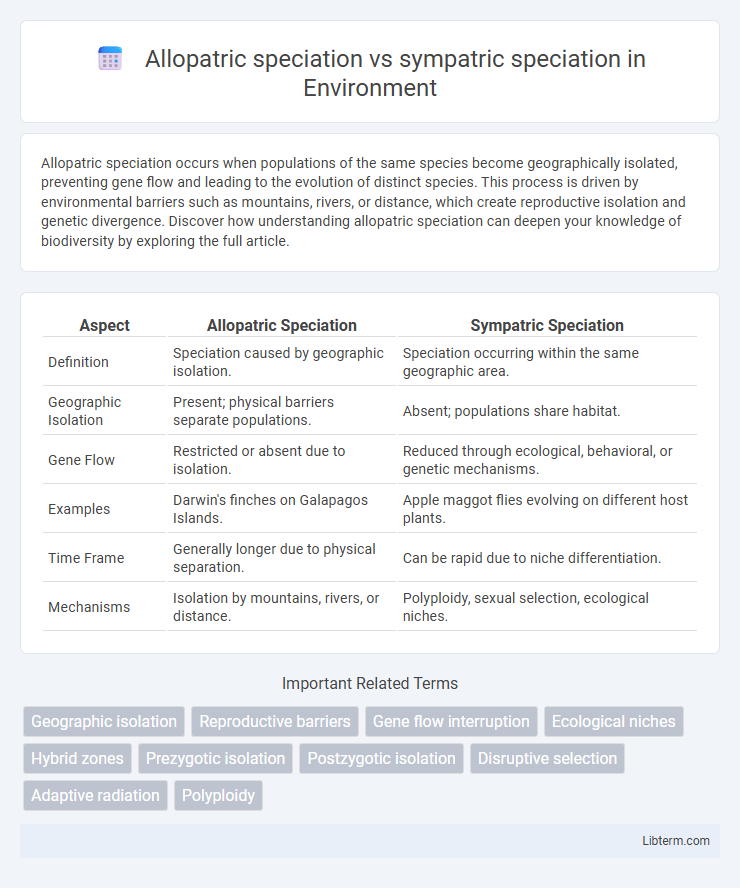Allopatric speciation occurs when populations of the same species become geographically isolated, preventing gene flow and leading to the evolution of distinct species. This process is driven by environmental barriers such as mountains, rivers, or distance, which create reproductive isolation and genetic divergence. Discover how understanding allopatric speciation can deepen your knowledge of biodiversity by exploring the full article.
Table of Comparison
| Aspect | Allopatric Speciation | Sympatric Speciation |
|---|---|---|
| Definition | Speciation caused by geographic isolation. | Speciation occurring within the same geographic area. |
| Geographic Isolation | Present; physical barriers separate populations. | Absent; populations share habitat. |
| Gene Flow | Restricted or absent due to isolation. | Reduced through ecological, behavioral, or genetic mechanisms. |
| Examples | Darwin's finches on Galapagos Islands. | Apple maggot flies evolving on different host plants. |
| Time Frame | Generally longer due to physical separation. | Can be rapid due to niche differentiation. |
| Mechanisms | Isolation by mountains, rivers, or distance. | Polyploidy, sexual selection, ecological niches. |
Introduction to Speciation
Speciation occurs when populations of a species diverge to form new species through genetic isolation and evolutionary mechanisms. Allopatric speciation arises from geographic barriers that physically separate populations, limiting gene flow and enabling distinct evolutionary paths. In contrast, sympatric speciation happens within a shared habitat, where reproductive isolation develops through ecological niches, behavioral differences, or genetic divergence despite physical proximity.
Defining Allopatric Speciation
Allopatric speciation occurs when populations of a single species become geographically isolated, preventing gene flow and leading to the formation of new species. This isolation can result from physical barriers such as mountains, rivers, or distance, causing genetic divergence through mutation, natural selection, and genetic drift. In contrast, sympatric speciation happens within a shared habitat without physical separation, often driven by genetic, behavioral, or ecological factors that cause reproductive isolation.
Defining Sympatric Speciation
Sympatric speciation occurs when new species evolve from a single ancestral species while inhabiting the same geographic region, without physical barriers to gene flow. This process often involves genetic mutations, polyploidy, or behavioral changes that create reproductive isolation within the population. Unlike allopatric speciation, which requires geographic separation, sympatric speciation relies on mechanisms like niche differentiation and assortative mating to drive divergence.
Key Mechanisms Behind Allopatric Speciation
Allopatric speciation occurs when populations of the same species become geographically isolated, leading to reproductive isolation through genetic divergence driven by mutation, natural selection, and genetic drift. The key mechanisms behind allopatric speciation include physical barriers such as mountains, rivers, or distance that prevent gene flow between populations. Over time, these isolated populations accumulate genetic differences significant enough to result in the formation of distinct species.
Key Mechanisms Behind Sympatric Speciation
Sympatric speciation occurs through mechanisms such as polyploidy, sexual selection, and ecological niche differentiation, which enable reproductive isolation within a shared geographic area. Polyploidy causes instant genetic divergence by chromosome duplication, while sexual selection drives divergence via mate preferences. Ecological niche differentiation reduces competition and gene flow by promoting adaptation to distinct resources or microhabitats in the same environment.
Genetic Divergence in Allopatric and Sympatric Contexts
Genetic divergence in allopatric speciation arises from physical isolation, which restricts gene flow and allows populations to accumulate distinct mutations over time, leading to reproductive barriers. In contrast, sympatric speciation occurs within a shared geographic area where genetic divergence is driven by mechanisms like polyploidy, behavioral isolation, or ecological niche differentiation, despite ongoing gene flow. The rate and nature of genetic divergence may differ significantly, with allopatric speciation typically showing more pronounced divergence due to complete isolation.
Examples of Allopatric Speciation in Nature
Allopatric speciation occurs when populations of a species become geographically isolated, leading to genetic divergence over time; classic examples include Darwin's finches in the Galapagos Islands and the Kaibab and Abert's squirrels separated by the Grand Canyon. In these cases, physical barriers prevent gene flow, resulting in distinct species adapted to different environments. Such examples highlight how geographic isolation drives evolutionary processes in nature.
Examples of Sympatric Speciation in Nature
Examples of sympatric speciation in nature include cichlid fish in African Great Lakes, Rhagoletis fruit flies adapting to different host plants, and certain species of polyploid plants like wheat. These organisms undergo speciation while inhabiting the same geographic area, driven by ecological niche differentiation, sexual selection, or polyploidy. Sympatric speciation contrasts with allopatric speciation, where geographic isolation is the primary factor for species divergence.
Comparing Evolutionary Outcomes
Allopatric speciation occurs when geographic barriers physically separate populations, leading to divergence through reproductive isolation and genetic drift, often resulting in distinct species with clear morphological differences. Sympatric speciation arises within a shared habitat through mechanisms like niche differentiation, polyploidy, or sexual selection, producing species that coexist spatially but avoid interbreeding. The evolutionary outcomes differ as allopatric speciation typically yields more pronounced genetic and phenotypic divergence, whereas sympatric speciation promotes ecological specialization and reproductive isolation without physical separation.
Significance and Implications in Biodiversity
Allopatric speciation, driven by geographic isolation, plays a critical role in generating significant biodiversity through the formation of distinct species separated by physical barriers, enhancing evolutionary divergence. Sympatric speciation, occurring without physical separation, contributes to biodiversity by promoting niche differentiation and adaptive radiation within the same habitat, often through genetic or behavioral isolation. Both processes are fundamental for understanding species richness, ecosystem complexity, and adaptive potential in changing environments.
Allopatric speciation Infographic

 libterm.com
libterm.com